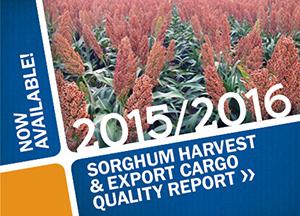The overall quality of the United States’ 2015 sorghum crop as it is prepared for shipment is very good, with 98 percent grading No. 2 or better according to the U.S. Grains Council’s (USGC’s) newly-released 2015/2016 Sorghum Harvest and Export Quality Report.
“During the last marketing year, the United States was the top exporter of sorghum, accounting for 75 percent of sales,� said USGC Chairman Alan Tiemann, who farms in Nebraska. “Our new report indicates that sorghum being shipped overseas from this year’s crop should be of the high quality that our customers demand, which is excellent for the buyer and the farmer.�
The new report combines information about quality at the end of sorghum harvest and as it moves to export facilities. It follows the release of the 2015/2016 Sorghum Early Harvest Quality Report, which examined 50 commodity grain sorghum samples collected from local grain elevators early in the harvest season.
According to the harvest quality section of the new report, U.S. sorghum samples taken when entering marketing channels had the following key characteristics:
- average test weight of 58.9 pounds per bushel (75.9 kilograms per hectoliter), with 97 percent of the samples within the range for U.S. No. 2 grade.
- low levels of broken kernels and foreign material (BNFM), with 91 percent of the samples within the range for U.S. No. 1 grade.
- average foreign material of 0.6 percent, which is within the range for U.S. No. 1 grade, indicating little cleaning will be required.
- low levels of total damage, with 99 percent within the range for U.S. No. 1 grade.
- no observed heat damage, which was expected for farm-originated samples.
- average moisture at the elevator of 14.1 percent, which is near optimum for harvest moisture.
According to the export cargo section of the new report, U.S. sorghum samples at the point of being loaded for overseas had the following key characteristics:
- an average test weight of 59.0 pounds per bushel (76.0 kilograms per hectoliter), with 100 percent of the samples within the range for U.S. No. 2 grade.
- low levels of broken kernels and foreign material (BNFM), with 96.2 percent within the range for U.S. No. 1 grade.
- average foreign material of 0.9 percent, with 98.3 percent within the range for U.S. No. 1 grade.
- low levels of total damage, with 99.5 percent within the range for U.S. No. 1 grade.
All samples collected for both reports tested below the U.S. Food and Drug Administration’s (FDA’s) action level of 20 parts per billion for mycotoxins and FDA advisory levels for DON.
The harvest and export cargo quality report will be rolled-out to international customers in conferences, seminars and one-on-one consultations in the coming months.
“The Sorghum Early Harvest Report that we released earlier this year was well received by our customers overseas, and we are hoping for similar results with this second report that completes the picture of the new U.S. sorghum crop,� Tiemann said.
The harvest information is based on 207 commodity grain sorghum samples taken from inbound elevators in defined areas within nine of the top sorghum-producing and exporting states.
The export cargo information is based on 182 commodity grain sorghum samples taken from export shipments as they underwent federal inspection and grading processes performed by the USDA’s Federal Grain Inspection Service (FGIS).
As a package, both of the sorghum reports are intended to provide reliable, timely and transparent information on the quality of the U.S. crop as it moves through export channels. They also use consistent methodology to permit the assessment of trends in future years.
Click here to view a PDF of the 2015/2016 Sorghum Harvest and Export Cargo Quality Report.


